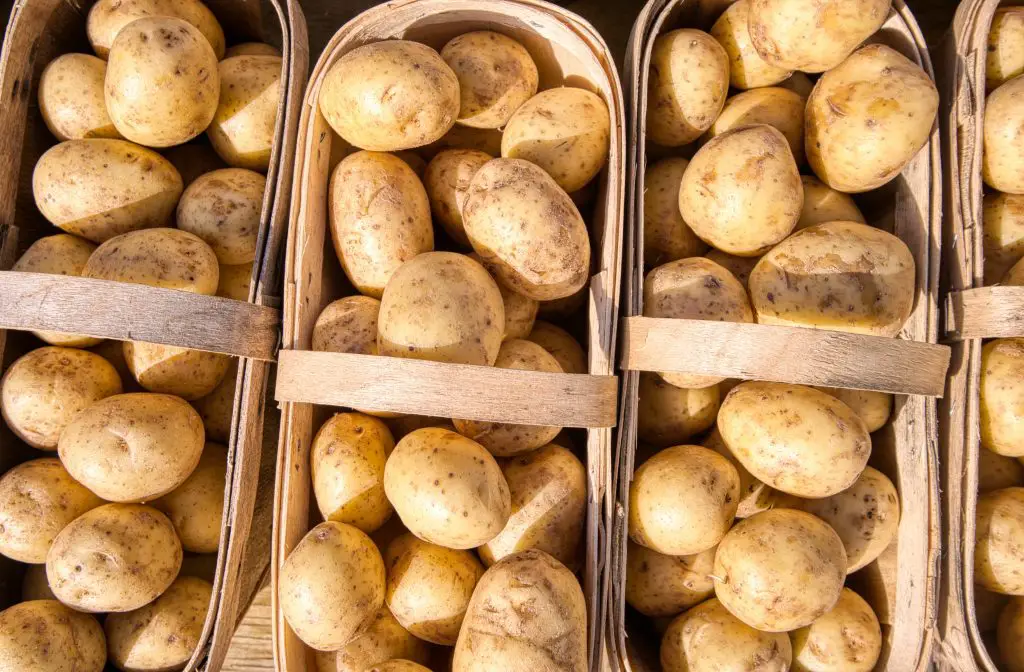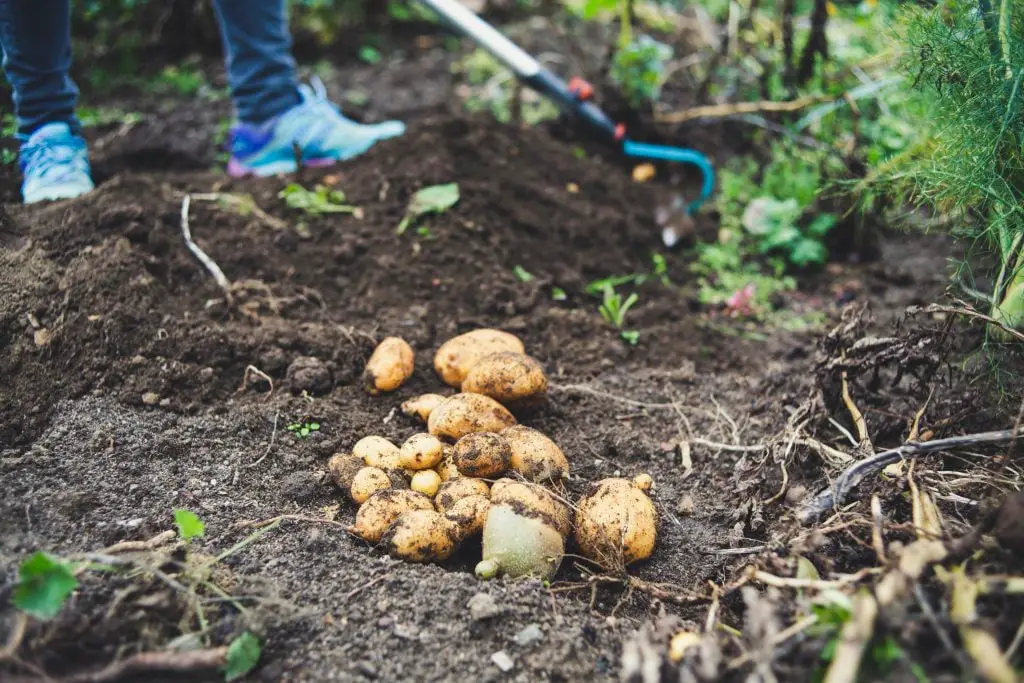Can You Plant Old Potatoes That Have Sprouted? Have you ever found a potato at the bottom of a draw that has begun to sprout, is looking decidedly unappetizing, and you are wondering what to do with it? One option is to plant it, but will it grow?
While fresh certified seed potatoes are best for growing a crop of potatoes, older store brought potatoes that have started to shoot can also be used to produce a crop. These can even include ones that have started going green or even begun to shrivel up a little.
However, planting commercially produced potatoes does come with some risk associated with it as they are not certified as disease-free. The key benefit of “certified Seed Potatoes is that they have been tested have for the presence of a selected range of common potato disease. The amount and type of disease that seed potatoes are tested for does vary depending on the region.
One example of this is the Australian seed potato scheme run by AUSVEG that tests for the presence of 14 different diseases and requires growers to maintain strict hygiene practices in order for them to be able to be labeled as ‘certified’.
eed Potatoes can be purchased at places like Seeds Now in the US or if you live in the UK at Thompson & Morgan.
Can You Plant Store Brought Potatoes That Have Not Sprouted?
Store brought potatoes that have not yet sprouted can also be used to plant in the garden however, it is advisable to chit them before they are planted in the ground to ensure that they are viable.
Chitting is a process used by gardeners to accelerate the growth of seed potatoes, it has been shown to be particularly useful for increasing the yield of early potatoes, click here for more details.
The ideal way to chit potatoes is to place them into an egg carton and expose them to light. Ideally, this should be done in a shed or greenhouse that is not heated as chitting at lower temperatures is known to produce a higher yield. The exposure to light will result in the potatoes producing shoots.
Chitting store brought potatoes is beneficial because many commercially sold potatoes have a sprout inhibitor applied to them. The sprout inhibitor is designed to reduce the tendency of potato to sprout to extend the shelf life of the product
When using the store potatoes to grow a crop the sprout inhibitor can be problematic because it can delay the growth of tuber increasing the chances of the tuber rotting in the ground before it can sprout.
Chlorpropham, the most common sprout inhibitor used is known to degrade quite slowly in the environment, a study published in the Journal of the American Chemical Society in 2001 indicates it could be detected on the surface of the Potatoes after 100 days at least.

How Much Can You Expect To Harvest From Each Seed Potato Planted?
Typically, a seed potato will produce between (1 to 4 lbs) 0.5 kg to 2kg, with the volume of the yield being dependent on the variety and the length of time the plants have spent in the ground. However, these values are based on using certified seed potatoes rather than store brought potatoes.
Within the seed potatoes, the types of potatoes are divided into first and second early and maincrop potatoes. First and second earlies are most commonly grown in the bags at the start of the season. They typically take 10-14 weeks and produce about 1 lb (0.5 kg) per seed potato. Main Crop Potatoes take about 15-20 weeks around 4 lbs (2 kg) per seed potato
I suspect that the volume of the yield for store brought potatoes is highly likely to quite variable and will be negatively impacted by the age of the potato.
Can You Cut Store Brought Potatoes In Half?
To make the most of tubers you have available whether they a certified or not you may want to consider cutting them in half. In a study we carried out in our trial garden we found that the yield for seed potatoes per segment of tuber planted was similar irrespective of whether it was cut in half or not.
The only limiting factor we found was that the size of the segment needs to be 70-80g in weight or higher otherwise there was a detrimental effect on the yield produce, to learn more click here.

How to Grow Potatoes?
Potatoes are a frost-sensitive vegetable, which means that the earliest time it can be planted is in early spring, just prior to the last frost. However, when the temperature in your garden remains below 50F (10C) it is best to delay planting until the soil warms up a little.
Prior to planting potatoes, it is best to prepare the soil, potatoes prefer a rich, moist but well-drained soil that is slightly acidic. A pH between 6.0 and 7.0 is ideal. To read more about the pH of the soil and how to adjust it click here.
To improve the fertility of the soil it is recommended that plenty of compost and manure be added and mixed in thoroughly. Once the soil is prepared dig a trench that is approximately 1 ft (30cm deep). The Potatoes should be placed about 1 to 1.5ft (30 to 45cm) apart and the trench should be partially backfilled, just enough to cover the potatoes.
Typically, shoots will appear around 2 to 4 weeks later, when this occurs the soil should be mounded up around the stems. Doing this will encourage the Potato plant to produce tubers at different levels in the soil result in a higher yield. Additionally, the soil placed on the plant will prevent the newly developed tubers from being exposed to light. If this occurs the tubers will begin to turn green and become poisonous.
After 10 to 14 weeks the potato plants will being to produce flowers. This is one of the best indications that the plant is approaching the point at which it can be harvested. Typically, we recommend that potatoes be harvested around 4 weeks after the appearance of flowers on the plant.
However, Potatoes can be left in the ground until the end of the season and picked as needed.
Conclusion
The use of store brought potatoes to crop a can be done however, this use of the potatoes does carry the risk of introducing disease into your garden. Additionally, of you are using old potato the crop that will be produced is quite uncertain.
If you are someone that is intending on developing a vegetable garden in your back yard over several years I would be inclined to purchase the certified seed potatoes because they produce a large reliable yield year in year out. And this risk simply does not outweigh the benefit. Maincrop potatoes will produce 30 to 40 times what you put in.
Related Articles
Can You Cut Seed Potatoes in Half?
Can I Plant Store Bought Potatoes?
What Are The Best Potatoes To Grow In Bags?
Does Earthing Up Potatoes Improve Yield? Is It Worth Doing?
How Much Sun Do Potatoes Need? Does The Yield Fall In Shade?
Are Potatoes A Root Vegetable?
How Late Can You Plant Potatoes? (And How To Maximize The Yield)
Can You Compost Potatoes? Or Will They Start Growing?

